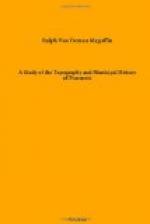[Footnote 235: C.I.L., XIV, p. 289.]
[Footnote 236: C.I.L., XIV, 2964-2969.]
[Footnote 237: C.I.L., XIV, 2964, 2965. No. 2964 dates before 14 A.D. when Augustus died, for had it been within the few years more which Drusus lived before he was poisoned by Sejanus in 23 A.D., he would have been termed divi Augusti nep. In the Acta Arvalium, C.I.L., VI, 2023a of 14 A.D. his name is followed by T i.f. and probably divi Augusti n.]
[Footnote 238: C.I.L., XIV, 2966, 2968.]
[Footnote 239: The first column of both inscriptions shows alternate lines spaced in, while the second column has the praenominal abbreviations exactly lined. More certain yet is the likeness which shows in a list of 27 names, and all but one without cognomina.]
[Footnote 240: C.I.L., XIV, 2967.]
[Footnote 241: Out of 201 examples of names from Praeneste pigne inscriptions, in the C.I.L., XIV, in the Notizie degli Scavi of 1905 and 1907, in the unpublished pigne belonging both to the American School in Rome, and to the Johns Hopkins University, all but 15 are simple praenomina and nomina.]
[Footnote 242: C.I.L., X, 1233.]
[Footnote 243: C.I.L., IX, 422.]
[Footnote 244: Marquardt, Staatsverw., I, p. 161, n. 5.]
[Footnote 245: Lex Iulia Municipalis, C.I.L., I, 206, l. 142 ff. == Dessau, Inscrip. Lat. Sel., 6085.]
[Footnote 246: Marquardt, Staatsverw., I, p. 160.]
[Footnote 247: C.I.L., XIV, 2966.]
[Footnote 248: Pauly-Wissowa under “Dolabella,” and “Cornelius,” nos. 127-148.]
[Footnote 249: The real founder of Sulla’s colony and the rebuilder of the city of Praeneste seems to have been M. Terentius Varro Lucullus. This is argued by Vaglieri, who reports in Not. d. Scavi, 1907, p. 293 ff. the fragment of an architrave of some splendid building on which are the letters ... Ro.LVCVL ... These letters Vaglieri thinks are cut in the style of the age of Sulla. They are fine deep letters, very well cut indeed, although they might perhaps be put a little later in date. An argument from the use of the name Terentia, as in the case of Cornelia, will be of some service here. The nomen Terentia was also very unpopular in Praeneste. It occurs but seven times and every inscription is well down in the late imperial period. C.I.L., XIV, 3376, 3384, 2850, 4091, 75, 3273; Not. d. Scavi, 1896, p. 48.]
[Footnote 250: C.I.L., XIV, 2967: ... elius Rufus Aed(ilis). I take him to be a Cornelius rather than an Aelius, because of the cognomen.]
[Footnote 251: One Cornelius, a freedman (C.I.L., XIV, 3382), and three Corneliae, freed women or slaves (C.I.L., XIV, 2992, 3032, 3361), but all at so late a date that the hatred or meaning of the name had been forgotten.]
[Footnote 252: A full treatment of the use of the nomen Cornelia in Praeneste will be published soon by the author in connection with his Prosographia Praenestina, and also something on the nomen Terentia (see note 92). The cutting of one of the two inscriptions under consideration, no. 2968, which fragment I saw in Praeneste in 1907, bears out the early date. The larger fragment could not be seen.]




